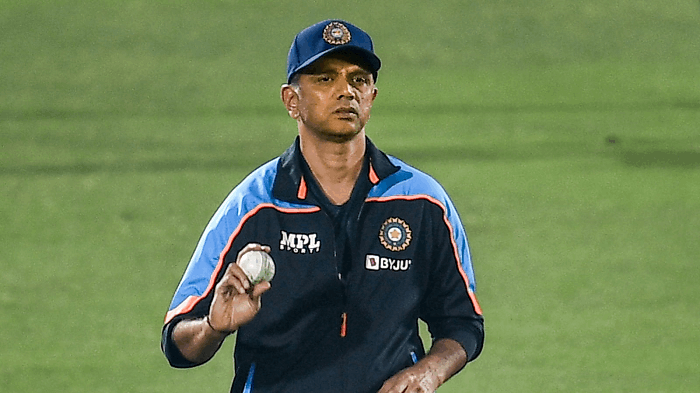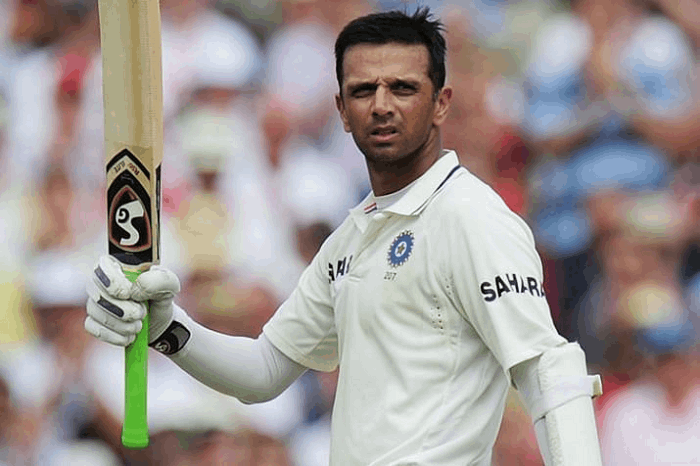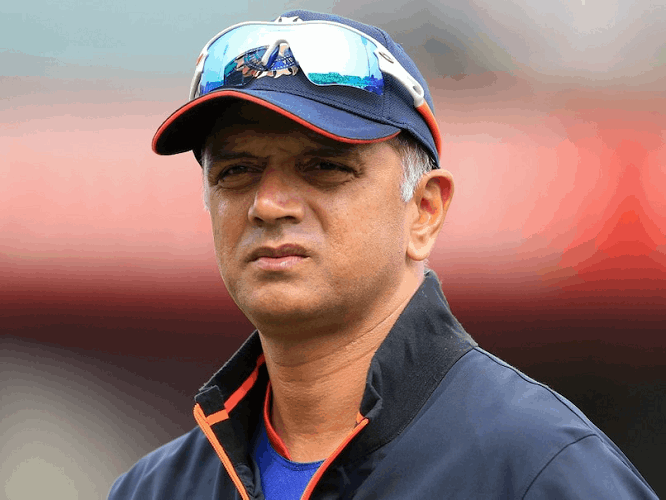Rahul Dravid: Biography, Age, Stats, Wife, News
Rahul Sharad Dravid, well known by his stage moniker The Wall, was born on January 11, 1973 is the former Indian cricketer, and captain. Currently serving as the team's head coach. He was the head coach of the India U-19 team at NCA (National Cricket Academy). The Under-19 squad he coached won the 2018 World Cup and placed second in the 2016 Under-19 World Cup. He is renowned for having a sophisticated batting style and approach. He was among the greatest cricketers in history, scoring more than 24,000 runs. He is frequently referred to as "The Wall" in cricket because of his defensive tendencies.

He started playing cricket when he was 12 years old and represented Karnataka at the U-15, U-17, and U-19 levels. He is now ranked fourth worldwide in Test cricket for runs scored. In 2004, he became the first player to score 100 points against every country that played Test matches. In his 286 matches, he never lost his wicket in the first test cricket ball, setting a world record. He once played 44152 minutes of Test cricket, which is the most of any batsman. The biggest partnership in Test cricket between two hitters is the 6920 runs scored by Rahul and Sachin while batting together. He received Player of the Year and Test Player of the Year honors at the maiden ICC awards ceremony in 2004.
Against the England team, he announced his ODI and T20I retirements in 2011. After leaving the international game, he also stopped playing first-class cricket. In 2012, he resumed playing in the IPL (Indian Premier League) as the captain of the Rajasthan Royals squad. Rahul decided to join the Bangalore-based Gosport Foundation after retiring. He coached aspiring Olympians in this foundation. Teenage golfer S. Chikkarangappa, para-swimmer Sharath Gayakwad, and Indian badminton star Prannoy Kumar were among the first group of athletes Rahul Dravid tutored.
The Rahul Dravid Family
In Indore, Madhya Pradesh, he was born into a Brahmin family. He attended St. Joseph's Boys High School in Bangalore, Karnataka, for his undergraduate studies and St. Joseph's College of Commerce in Bengaluru for his business degree. While studying for his MBA at St. Joseph's College of Business Administration, he was chosen for the squad.
Rahul's mother was a professor at Bangalore's University Visvesvaraya College of Engineering. His father was employed by Kissan, a business renowned for its jam production. Rahul's pals gave him the moniker "Jammy" as a result. Additionally, he has a younger brother named Vijay.
A Career in International Cricket
First-Time Abroad
Because of his consistently strong play in domestic cricket, Rahul received his first summons to the national cricket team in 1994 for the Wills World Series. He was, however, denied the opportunity to take part in the playing of 11. Following this, he returned to playing domestic cricket and worked hard to earn a spot in the playing 11 of the national side. Despite his best efforts, he could not secure a spot on the 1996 World Cup national cricket team.
After the 1996 World Cup, he finally had the opportunity to play, and on April 3, 1996, he replaced Vinod Kambli and made his ODI debut against Sri Lanka in Singapore for the Singer Cup. However, he was ineffective and unimpressive in the game. He only scored 3 runs in that game before being bowled by spinner Muttiah Muralitharan. His poor play continued in a match against Pakistan, where he only managed to score 4 runs before being run out.
He then made his Test Debut in a matchup with the England team. First, he successfully competed in two exhibition games versus Leicestershire and Gloucestershire. However, it did not enable him to secure a spot in the starting lineup for the first Test, but he had the opportunity to make his Test debut in place of Sanjay Manjrekar during the second Test against England. In that game, he batted at No. 7 and scored 95 runs while forming a strong partnership with Sourav Ganguly (who was making his debut), but was removed by Chris Lewis before reaching his first-ever century in Test cricket. He did, however, have another opportunity in the next Test series against British University, where he recorded his debut century. With his portrayal in this series, he captured everyone's affection.

Dravid's Ascension
After his debut, Rahul's international career was unsuccessful in several long and short-format matches. In Test matches, he established himself early, but it took him some time and worked to succeed in ODIs.
It was his first Test in India after a successful Test debut in England, and he played in one Test against Australia in Delhi. He amassed 40 runs throughout the opening innings at position six in the batting order. The following Test series against South Africa was at home, and he was allowed to bat at No. 3. He only managed 175 runs at an average of 29 in 3 Test matches at the time; therefore, his performance in this position was not particularly noteworthy.
India took to play in three Test matches with South Africa in the continent. The Indian team was ruthlessly knocked out for 66 runs on a Durban wicket with substantial bounce, seam action, and a target of 395 runs. Dravid, who batted at position six and scored 27 (not out) in the innings, was the only Indian batsman to reach double digits. He was granted one more chance to play third base during the second inning of the second Test. The team could not win or draw the game despite Cullinan's century, which prevented South Africa from suffering a severe defeat. He ran 81 runs in the second inning after scoring 148 in the first. His first-ever Test Man of the Match honor came from his 277 runs, averaging 55.40 runs.
Dravid played in five Test matches against the Windies in the following series, scoring 360 runs at an average of 72, including four fifty-plus innings. With Shivnarine Chanderpaul, he shared the Man of the Match honor for the fifth game's 92 runs scored. In 1996–1997, he led all run scorers with 852 runs scored in 12 games at an average of 50.11. He also led all half-centuries scorers with 106.
He joined Gundappa Vishwanath as the only Indian with six fifties against Australia and Sri Lanka in six straight innings. He played 22 Test matches after 1997–1998 and hit 15 half-centuries, as well as the 90s and a hundred four times.
He averaged 62.66 runs per match during the 1998–1999 season, scoring 752 runs in 7 games. His four hundred and fifty-six runs made him India's all-time leading run-scorer. In a subsequent test match against Zimbabwe, which India ultimately lost, Dravid scored the most runs with 118 in the first inning and 40 in the second. He scored the most runs for India in both innings.
The first game against New Zealand that followed the Zimbabwe series was called off before a single ball was delivered. Dravid's first-ever duck in his Test career occurred in the second test match. Despite this, he scored 190 runs in the first inning and 103 runs in the second inning of the third test match, making him the third player to do it. Vijay Hazare and Sunil Gavaskar have only accomplished this in the past. Although he amassed the most runs in the series (321 runs at an average of 107 in two games), the team could not defeat New Zealand.
After a month, India and Pakistan played a test series, with India losing the first test match despite Dravid's modest run totals. Anil Kumble was the only Indian player ever to take 10 wickets in an inning when he took them against Pakistan later in a champions series, making it a landmark encounter for India. Mushtaq Ahmed's catch was taken by Dravid (8th wicket of Kumble). Following this first Test of the championship series, India faced Sri Lanka in the second game, in which Dravid amassed his fourth century of the year. However, Jayawardene's shot hurt him. In the second inning of the game, the ball smacked into him while he was fielding it and went through the grill of his helmet. As a result, the Indian team could not advance to the finals because the game was a draw.
While Dravid struggled in the one-day international format, his Test career was when he was at his best. Since making his debut in 1998, he has not played frequently, but in Toronto's 1996 Friendship Cup encounter versus Pakistan, the fight ended. He received the first-ever ODI Player of the Match award in this series after hitting 220 runs in five games at a pace of 68 and taking home the first-ever ODI Man of the Match title. He scored 280 runs in eight games of the SBI International ODI against South Africa in 1996, and for his 84 runs in the series' last encounter, he was named Man of the Match. In 1997, in Chennai, against Pakistan, he scored his first ODI century. With 189 runs at an average of 94.50, he scored the most for India in the quadrangular series. However, his ODI career was cut short by 14 runs in two games during the Pepsi Sharjah Cup in 1996, 20 runs during the Singer Cup, and 65 runs in four games during the Friendship Cup (1998).
The First World Cup
He scored 50 runs against South Africa in his World Cup debut at Hove, England, but only 13 runs against Zimbabwe in the following match. Despite these discrepancies, the Indian team lost both contests. Following losses in the first two games, they required victories in the final three contests to advance to the Super Six stage. During their 237-run partnership against Kenya at Bristol, in which Dravid notched his first World Cup century, the duo was successful. By 94 runs, India triumphed in the game. Dravid took over as the wicketkeeper for the remainder of India's innings against Kenya after Mongia sustained an injury. He took over as the full-time wicketkeeper after Mongia's injury in the following match at Taunton against Sri Lanka.

He and Sourav Ganguly had one more 318-run partnership during the match against Sri Lanka. In that inning, he scored 145 runs, including six and seventeen fours, to become the second World Cup player to hit two consecutive centuries. In the last group encounter against England, he also hit a half-century, helping India win and advance to the super six matches. He only scored two runs in the Super Six matches—two—against Australia, 61—against Pakistan and 29—against New Zealand. Unfortunately, he could not assist India in reaching the semifinals as they suffered defeats to Australia and New Zealand.
In the four games he played in the Aiwa Cup in August after the World Cup concluded, he only scored 40 runs. However, he returned to form following this cup and scored the most runs in two straight series. He earned the Man of the Match honor for his efforts in the series finale of the DMC Cup, where he scored 77 runs and took 4 catches. Following this, India played a three-match series in India, where he scored 144 runs in the second inning to save India from losing the first Test after being all out for just 83 runs. He became the leading run-scorer in the world in 1999 after scoring 782 runs in 19 games.
This was Dravid's sixth century in tests and his first in India. After the Test match series, India played New Zealand in an ODI match in which he made 240 runs throughout five innings, leading India to a 3-2 series victory. His best ODI inning of 153 runs in this series occurred in Hyderabad, where Dravid and Sachin scored 331 runs (the highest partnership in ODI till 2015). Since then, Dravid has played in 43 ODI innings, scoring 1761 runs at a 46.3 average.
Dravid didn't do well with his bat during India's 1999 trip to Australia for a three-match Test series, and India fell behind 0-3. Dravid struck three half-centuries in a triangular series (ODI) played in Australia; however, the team could not advance to the series' finals.
The Captaincy of Rahul Dravid
Dravid led India to victory in Pakistan. He was named captain in the series against Pakistan, where Sourav Ganguly (the regular captain) sustained an injury. When he made a choice that sparked debates, he was playing his second Test as captain.
When Sachin Tendulkar was just 6 runs away from reaching his double century in the Test on the second day, and Sehwag had amassed 309 runs, he declared an inning, and the match was over. As the Pakistani batters were already worn out from two days of fielding, Rahul wanted to capitalise on the previous wickets they had taken. Players from Pakistan had fielded for more than 150 overs when he made this choice.
Being a Coach
As the head coach of the Rajasthan Royals in the IPL, he assumed control in 2014. In 2015, he was hired to lead the India A and U-19 teams. India competed in the 2016 U-19 WC under his direction and advanced to the final, but they fell short. They defeated Australia by 8 wickets later in the 2018 U-19 WC to claim the championship. Rahul Dravid is a valuable resource for players and superstars of today like Ishan Kishan, Washington Sundar, and many others.
Dravid was named the Head of the Cricket at NCA in 2019 after spending four years coaching junior cricket. His appointment as the Indian National Team's coach came later in 2021.
Family
Vijeta Pendharkar, a Brahmin family member like himself, was married to Dravid. She came from a commander's family in the air force. Samit, born in 2005, and Anvay born in 2009 were Dravid and Vijeta's two children.
Achievements
- For his accomplishments in cricket, he received the Arjuna Award in 1998.
- He received India's fourth-highest civilian honor, the Padma Shri, in 2004.
- In 2013, he was awarded the Padma Bhushan.
- He was named Wisden Cricketer of the Year in 2000.
- He was named the ICC Test Player of the Year and Cricketer of the Year in 2004.
- 2018 saw him get the ICC Hall of Fame Award.